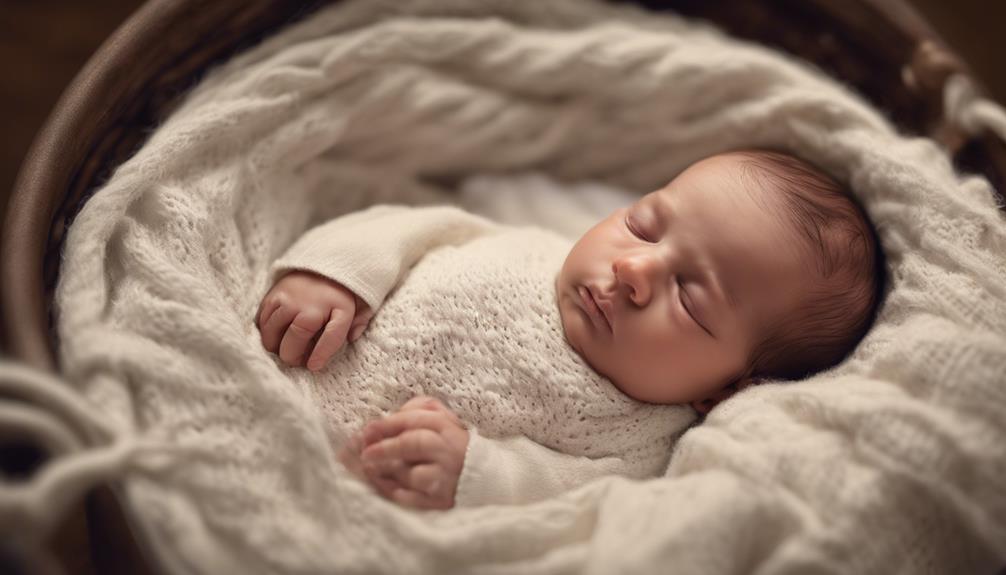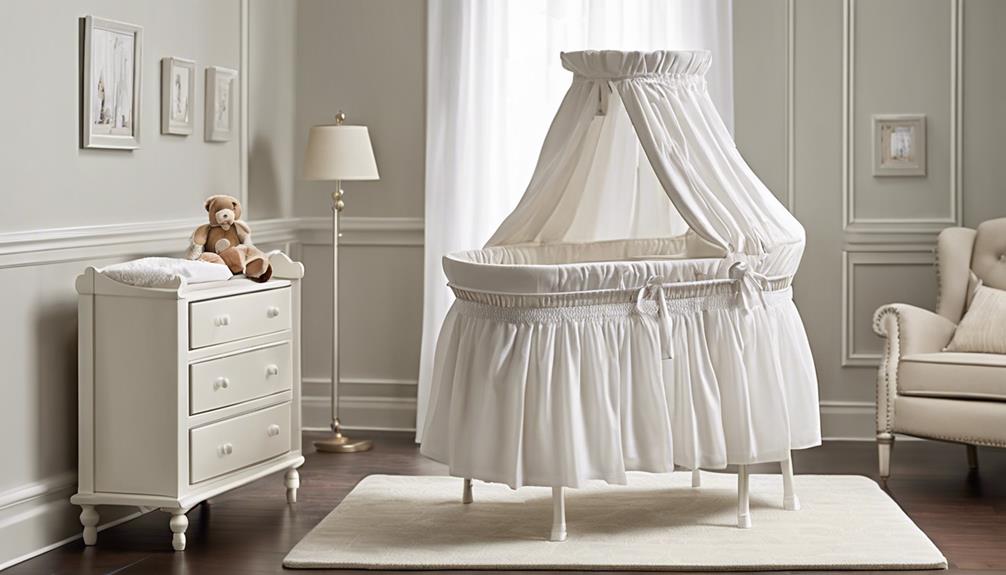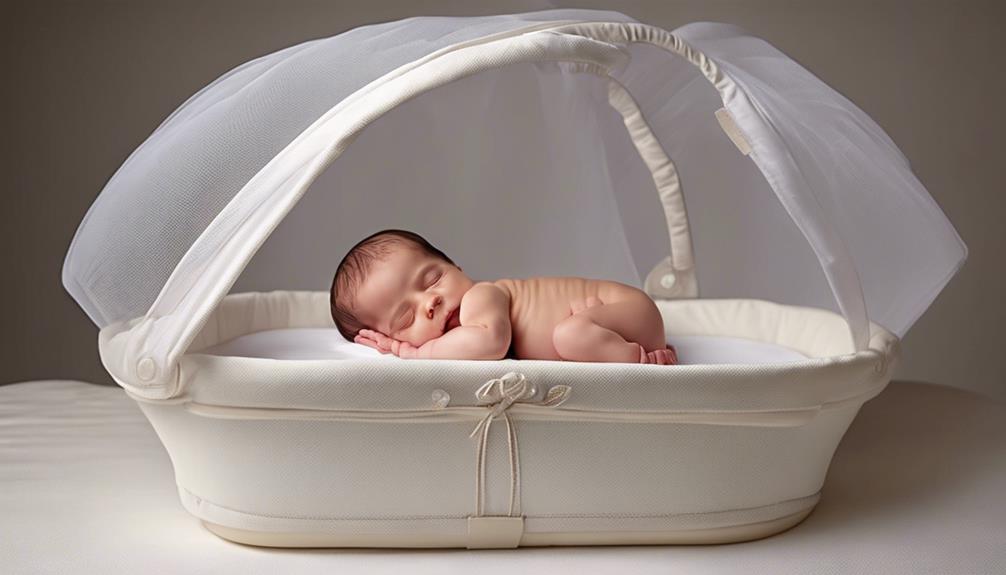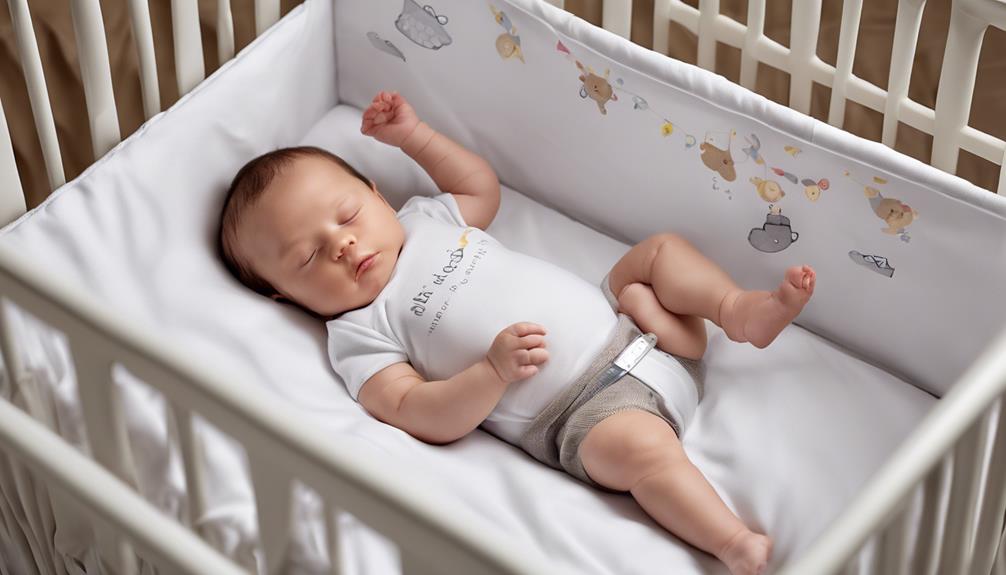Have you ever wondered about the safest way for newborns to sleep in a bassinet? Understanding the ins and outs of this critical aspect of infant care can make a significant difference in your baby's well-being.
From the positioning to the bedding choices, every detail plays an essential role in creating a secure sleep environment for your little one.
Let's explore the important guidelines and tips that can help you navigate this important aspect of caring for your newborn.
Key Takeaways
- Always position your newborn on their back in a bassinet to reduce SIDS risks.
- Use a firm mattress and avoid soft bedding like blankets and pillows.
- Choose fitted sheets and lightweight, breathable bedding for a safe sleep environment.
- Monitor your baby's sleep closely and respond promptly to any changes or signs of discomfort.
Setting Up the Bassinet Environment
When setting up the bassinet environment, always prioritize safety by adhering to specific guidelines to create a secure sleeping space for your newborn. Place the bassinet in your room to facilitate monitoring and bonding with your baby. Guarantee the bassinet rests on a flat, firm surface to minimize the risk of suffocation. Remember to utilize a tight-fitted sheet on the mattress to prevent entanglement hazards.
Keep the bassinet free of loose bedding, pillows, and soft objects to maintain a safe sleep environment for your little one. Additionally, position the bassinet away from cords, curtains, and other potential hazards that could pose a danger to your newborn while sleeping. By following these safety measures, you can create a cozy and secure sleeping haven for your baby, promoting peaceful and restful sleep for both your little one and yourself.
Positioning Your Newborn Safely
To guarantee your newborn's safety while sleeping in the bassinet, always remember to position them on their back to reduce the risk of Sudden Infant Death Syndrome (SIDS).
When it comes to creating a safe sleep environment for your little one, here are some essential tips to keep in mind:
- Use a firm mattress: Opt for a snug-fitting, firm mattress in the bassinet to prevent suffocation hazards.
- Avoid soft bedding: Keep blankets, pillows, and other soft bedding out of the bassinet to maintain a safe sleep space for your newborn.
- Prevent accidents: Make sure the bassinet is free from potential hazards like cords, curtains, or toys that could pose risks during sleep.
Choosing the Right Bedding

Choosing the right bedding for your newborn's bassinet is important to ensure a safe and comfortable sleeping environment. When it comes to your baby's crib, opt for fitted sheets designed specifically for the bassinet. These sheets guarantee a snug fit, reducing the risk of suffocation.
It's essential to avoid loose bedding, pillows, or stuffed animals in the bassinet to lower the chances of SIDS. Lightweight and breathable fabrics are ideal for bedding to help regulate your baby's body temperature while they sleep. Consider using sleep sacks or wearable blankets instead of traditional blankets for a safer sleep environment.
Always check that the bedding in the bassinet is free of any choking hazards or entanglement risks that could pose a danger to your little one. Prioritizing safety and comfort with the right bedding choices can help your baby sleep soundly and securely.
Monitoring Your Baby's Sleep

Monitoring your baby's sleep patterns and movements using a reliable baby monitor is essential for guaranteeing a safe and restful sleep environment. It provides peace of mind and allows you to respond promptly to any changes in your baby's sleep behavior.
Here are some key points to ponder when monitoring your baby's sleep:
- Guarantee a Safe Sleep Environment: Regularly check the surroundings to diminish the risk of SIDS and create a secure sleeping space for your newborn.
- Watch for Signs of Discomfort: Monitor your baby's sleep patterns for any signs of restlessness or discomfort, which may indicate the need for adjustments.
- Take into account Video or Smart Monitors: Video monitors allow you to visually check on your baby without disrupting their sleep, while smart monitors with sleep tracking features provide detailed insights into your baby's sleep patterns.
Additional Tips for Safe Sleep

Regularly guaranteeing a safe sleep environment in the bassinet is crucial for promoting your newborn's well-being and reducing the risk of Sudden Infant Death Syndrome (SIDS).
To enhance safety, always place your newborn on their back to sleep in the bassinet. Opt for a firm surface without loose bedding or soft objects to reduce potential hazards.
Room-sharing with your baby in the bassinet is advisable for at least the first six months; it allows for easier monitoring and strengthens bonding.
When dressing your newborn for sleep, choose light sleep clothes to prevent overheating in the bassinet and maintain a comfortable temperature.
Remember, it's best to prioritize safe sleep practices over relying on home monitors for SIDS prevention to ensure your baby's safety and well-being.
Frequently Asked Questions
How Should the Newborn Be Positioned When in the Bassinet?
We position newborns on their back in the bassinet to reduce SIDS risk. Side or stomach positions are unsafe according to AAP. Verify the head is free, and the bassinet is clear of loose items for safe sleep.
Should a Bassinet Have Mesh Sides?
We believe mesh sides are essential in a bassinet for the best possible safety and comfort. They enhance air circulation, prevent entrapment hazards, and reduce the risk of overheating. Mesh sides also allow parents to easily see their baby.
Do You Put a Newborn on Their Side in the Bassinet?
We never place a newborn on their side in a bassinet. It's important for safe sleep to position them on their back. Side sleeping can obstruct their airway. Prioritize safety by always placing your newborn flat on their back in the bassinet.
Should Newborn Daytime Naps Be in Bassinet?
Absolutely, newborn daytime naps should be in a bassinet. It's the safest choice for our little ones, promoting healthy sleep habits and providing a cozy spot for them to rest during the day.
Conclusion
In the cozy confines of a bassinet, newborns can drift off to sleep peacefully and safely. By following guidelines and creating a nurturing environment, parents can guarantee their little ones rest soundly.
Imagine the soft rustle of sheets, the gentle rise and fall of a tiny chest, and the contented sigh of a sleeping baby. With proper care and attention to detail, every parent can provide their newborn with the gift of a secure and restful slumber.









